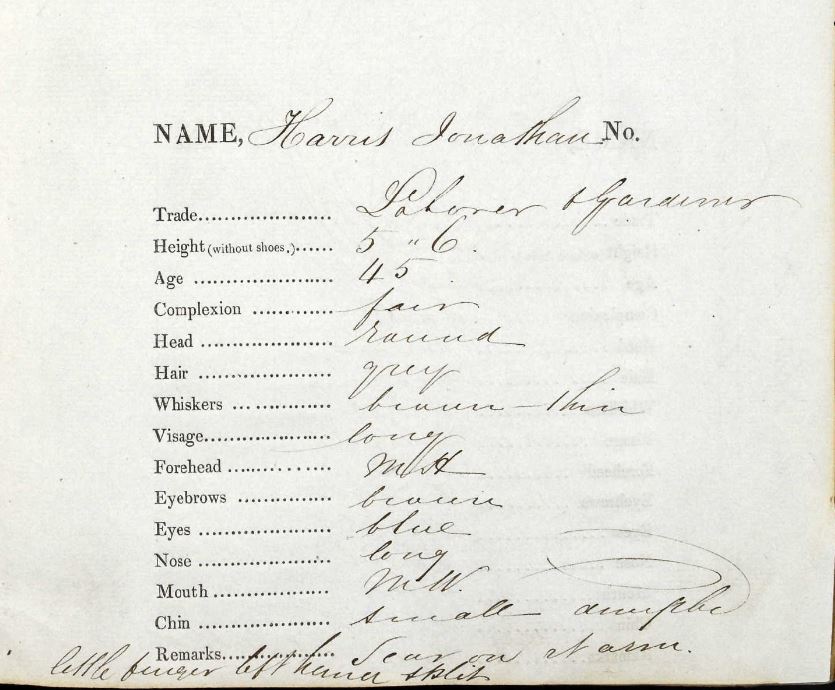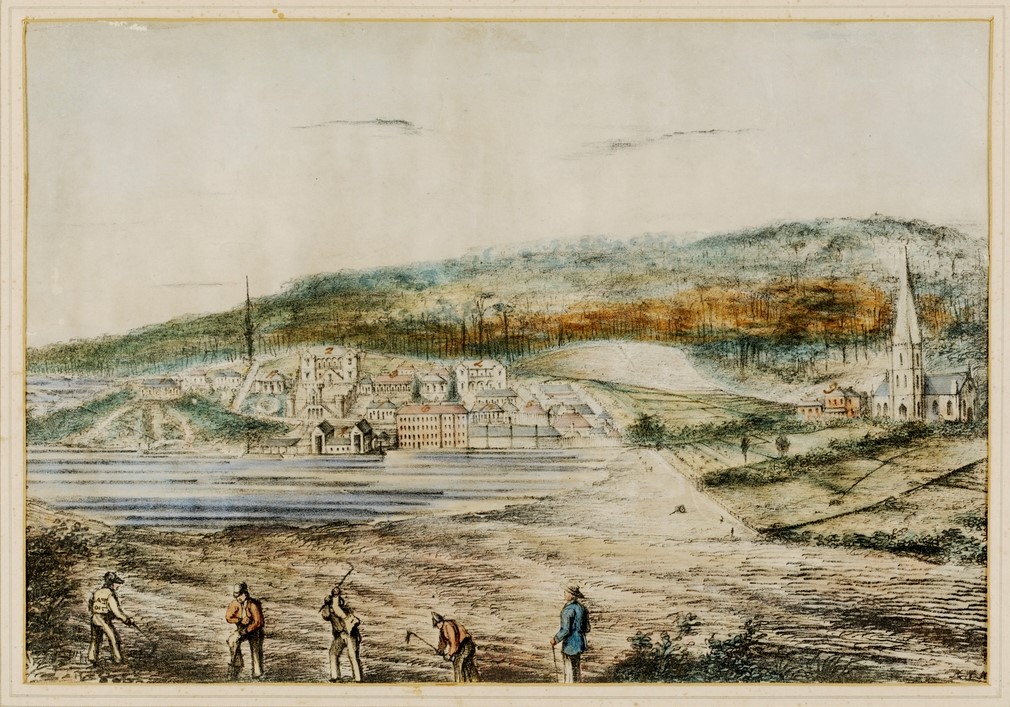On the 3rd January 1826, Jonathan Harris (alias Alcorn) arrived in Sydney Cove as a convict aboard the Marquis of Hastings. Lucky to have survived the penal system involving a stay on the hulks and the long sea voyage, Harris had actually used up not two, but three of his lives by the time he arrived at Sydney Cove. His crime of burglary of a dwelling house and stealing goods valued at almost nineteen pounds initially earned him a death sentence at Sussex Assizes in March 1825. Jonathan’s sentence was later commuted to transportation for life, the first of his known escapes from drastic consequences.
Harris was born in 1800 in Mayfield, Sussex and had married Elizabeth Baker in November 1821. Jonathan and Elizabeth had three children in Uckfield, Sussex before his conviction: Jonathan jnr., Elizabeth and Henry. After a successful plea, Elizabeth was allowed to join Jonathan in New South Wales in early 1831, and the couple went on to have Sophia, Thomas, and George Jarvis. On 30th March 1836 Elizabeth was riding on a wagon on the Bong Bong to Cambelltown Road nursing George Jarvis, when it hit a ridge on the road and overturned. Baby George was thrown clear, but one of the wheels ran over Elizabeth and she died almost immediately. She was buried at Bungonia (thanks Pam).
Jonathan Harris convict description (second transportation) 1842, courtesy Tasmanian Archive & Heritage Centre
Jonathan gathered himself and remarried Ann Grubb who was 20 years his junior, in 1840 in Goulburn. He had gained a Ticket of Leave by then, but his marriage to Ann, who came from a respectable Methodist family, is nonetheless surprising. In October 1841, Jonathan was issued a Conditional Pardon in recognition of his good conduct since arriving in the colony. Sir George Gipps who issued the Pardon was perhaps a little hasty. Less than twelve months after his Pardon, Jonathan and 20 year old Jonathan junior were convicted at the Parramatta Quarter Sessions on a charge of “stealing from a person”. Major Edmund Lockyer had accused Harris senior of stealing £47 from an old man, and several other serious crimes. Jonathan was sentenced to 15 years and Jonathan junior to 10 years transportation to Van Dieman’s Land (later Tasmania). Jonathan was sent to Cockatoo Island where he spent 12 months, before being transported to the Port Arthur penal colony in Van Diemen’s Land aboard the “Waterlily”. Jonathan junior was transported almost immediately to Van Diemen’s Land aboard the “Sir John Byng”.**
In their short marriage Ann Grubb bore Jonathan two children: William Thomas and George Robert Grubb, the latter born six months after Jonathan’s conviction. Ann took the opportunity of Jonathan’s transportation to Van Diemen’s Land to remove herself from the marriage. She had little choice as she was left destitute after all of Jonathan’s assets were sold off after his conviction, and Ann was refused any portion of the proceeds. She went on to have five known children with William Oliver/Olliver.
Port Arthur 1843, unknown artist, courtesy State Library of New South Wales
In Tasmania, Jonathan senior bigamously married fellow convict Mary Ann Squires in 1853. Mary Ann was 25 years younger than Jonathan, and younger than two of his children. The couple had three children in Tasmania – George, Edward and Walter – before moving to Benalla in Victoria between 1855 and 1857. Jonathan’s eldest daughter Elizabeth was by then married to successful Wangaratta businessman William Henry Clark, and his son George Jarvis was living in Benalla with his young family. In Benalla, Jonathan and Mary Ann had further children: Francis, Albert, Frances Alice, Frederick, John Phillip, Charlotte Rebecca and Lucy Rosetta, the last born the year Jonathan turned 73. This made a total of nine children to Jonathan and Mary Ann.
From his humble beginnings as a gardener and ploughman in rural Sussex, and probably thinking he had seen his wife and three infant children for the last time when left England’s shores in the summer of 1825, Jonathan went on to found somewhat of an Australian dynasty. Eighteen known children in total were born in three different colonies and in Sussex, England. With his first wife Elizabeth Baker, six children all survived to adulthood; with his second wife Ann Grubb, two sons both survived to adulthood; and with his third wife Mary Ann Squires, ten children were born, one of whom died as a 19 year old, and two who are currently unaccounted for. His last child died in 1961, 70 years after his own death. Jonathan had at least 90 grandchildren living at the time of his death in Benalla, Victoria in October 1891. More grandchildren were born after his death, the last known in 1912, 113 years after Jonathan’s birth. A total of 141 grandchildren have been identified and the count has not ended!
DNA matches are bringing all these descendants together. If you are a descendant and want to know more about DNA testing, please get in touch using the ‘Contact’ page.
**Many more crimes were committed by Jonathan. Covering them would take a few posts, but for the purpose of this post I have only mentioned those crimes that directly related to his “dynasty” – his marriages and children. On my family tree database I have amused myself by recording Jonathan’s occupation as “career criminal”.








Just read your webpage about Jonathan Harris’s. I am interested in which DNA testing others have been using to link up.
Hi Kathryn
Ancestry has the biggest database of tests so it remains the best option for Australians.
Once you have done an Ancestry test you can upload that data to MyHeritage and use their tools for a small fee.
I have identified 83 Jonathan Harris descendants who match me at Ancestry, and about the same number that clearly descend from Jonathan but I haven’t been able to identify them in my tree just yet.
Hope that helps. 🙂
I am from JH snr MA via d Charlotte
Another cousin! Welcome Terry. Have you done a DNA test?
Very interesting.
My mother was Joan Connolly, nee O’Brien’s. Married James Connolly.
I am a direct descendant of Jonathan Harris and Elizabeth Baker,their son George Jarvis Harris ,was my great great grandfather, thank you it’s so very interesting reading about his life
Hi Lorraine,
Great to hear from another cousin. I see that we are also a DNA match to each other. 🙂
Thanks for dropping by!
Hi Lorraine, my gg grandmother Ann Olliver was married to Johnathan Harris. I have just discovered his first wife Elizabeth Baker Harris has a plaque in the Bungonia Cemetery. To say she us buried there in an unknown grave.
Hi
I am descendent of Jonathon & Mary Ann Harris through Frances Alice Harris / McEwan whose daughter Ada McEwan was my Great Grandmother.
I am looking to understand more of my ancestry and fill a gap about one of Frances Alice McEwan’s Grand daughters who might have gone by the name of Gladys Baker or Mrs. A Baker of Philip St Coburg as listed on her funeral notice of Francis Alice McEwan in 1940 after the funeral at Falkner Cemetary.
I believe she may be the daughter of Ada McEwan / Charlton but possibly raised by other members of the family.
There is no info l can find on her but l do notice the maiden name of Jonathan’s first wife was Baker!?
Any info on this or other ancestors would be greatly appreciated.
Kind regards
Lainie
Hi Lainie,
Nice to hear from a cousin. 🙂
I’ll send you an email soon.
Kind regards,
Jen
Career Criminal is apt. However, The Euroa Advertiser reported his death with respect. He died of of the the influenza epidemic – the pandemic of the day. ” Jonathan Harris, aged 91, a colonist of sixty-nine years, and a resident of Benalla for thirty-four years, is amongst the fatal cases reported.”
He WAS given a lot of respect in his later years. Perhaps he had mended his ways or mellowed in his old age? His death was so long after his known crimes that I am hoping he was able to leave them all behind when he moved from Tasmania. His prolific breeding probably also meant there were a lot of relatives to be offended should he not been given a send off fitting of a pioneer. Thanks for dropping by cousin John! 🙂